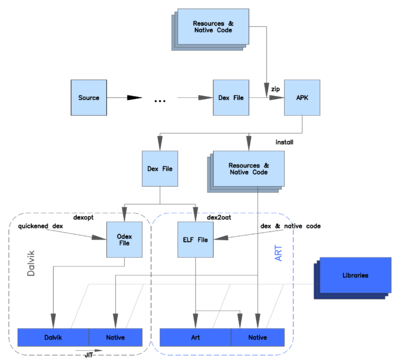Android Runtime
Android Runtime(ART) is an applicationruntime environmentused by theAndroidoperating system.ReplacingDalvik,theprocess virtual machineoriginally used by Android, ART performs thetranslationof the application'sbytecodeintonative instructionsthat are later executed by the device's runtime environment.[2]
Overview[edit]

Android 2.2 "Froyo"broughttrace-based just-in-time (JIT) compilationinto Dalvik, optimizing the execution of applications by continuallyprofilingapplications each time they run and dynamicallycompilingfrequently executed short segments of their bytecode into nativemachine code.While Dalvikinterpretsthe rest of an application's bytecode, native execution of those short bytecode segments, called "traces", provides significant performance improvements.[3][4]
Unlike Dalvik, ART introduces the use ofahead-of-time (AOT) compilationby compiling entire applications into native machine code upon their installation. By eliminating Dalvik's interpretation and trace-based JIT compilation, ART improves the overall execution efficiency and reduces power consumption, which results in improved battery autonomy onmobile devices.At the same time, ART brings faster execution of applications, improvedmemory allocationandgarbage collection(GC) mechanisms, new applicationsdebuggingfeatures, and more accurate high-level profiling of applications.[2][5][6]
To maintainbackward compatibility,ART uses the same input bytecode as Dalvik, supplied through standard.dexfiles as part ofAPK files,while the.odexfiles are replaced withExecutable and Linkable Format(ELF) executables. Once an application is compiled by using ART's on-devicedex2oatutility, it is run solely from the compiled ELF executable; as a result, ART eliminates various application execution overheads associated with Dalvik's interpretation and trace-based JIT compilation. A disadvantage of ART is that additional time is required for compilation when an application is installed, and applications take up slightly moresecondary storage(usuallyflash memory) to store the compiled code.[2][5][6]
History[edit]
Android 4.4 "KitKat"introduced atechnology previewof ART as an alternative runtime environment to Dalvik, which remained the default virtual machine.[7][8]In the subsequent major Android release,Android 5.0 "Lollipop",Dalvik was entirely replaced by ART.
Android 7.0 "Nougat"switched itsJava Runtime Environmentfrom the discontinuedApache HarmonytoOpenJDK,introducing a JIT compiler with code profiling to ART, which lets it constantly improve the performance of Android apps as they run.[9]The JIT compiler complements ART's AOT compiler, helping to improve runtime performance and save storage space by identifying "hot code" (code which is frequently used, runs on the UI thread or affects startup time), which the AOT compiler compiles to machine code while the device is idle and charging. Less-frequently used code relies on JIT compilation.[10][11]
Android 9 "Pie"reduced the amount of storage used byAPKsby using compressedbytecodefiles, andprofilerdata can be uploaded to Google Play servers to be bundled with apps when downloaded by users with a similar device, which shortens download time from Google Play by up to 40%. Google Play cloud profiles allow apps to be optimized on installation, which helps avoid the initial performance issues present on Android 7.0 to 8.1.[12]
In July 2021,[13]the concept of baseline profiles was introduced. Baseline profiles are ART profiles that define methods and classes which should undergo AOT compilation from an app's first launch, and are compatible with Android 7.0 and later. They provide similar functionality to Android 9's Google Play cloud profiles when they are not available and automatically merge with cloud profiles when they are available.[14]
ART was updated with a newgarbage collector(GC) utilizing theLinuxuserfaultfdsystem callinAndroid 13.[15][16][17]It reduces memory pressure, compiled code size andjank,and prevents the risk of killing apps because of low memory duringgarbage collection.[17]Other changes also improve app startup, reduce jank and improve performance.[17]Because of the Mainline project,Android 12's ART will also be updated.[15]
See also[edit]
- Android software development– various concepts and software development utilities used for the creation of Android applications
- Android version history– a history and descriptions of Android releases, listed primarily by their official API levels
- Comparison of application virtualization software– various portable and scripting language virtual machines
- Virtual machine– an emulation of a particular computer system, with different degrees of implemented functionality
References[edit]
- ^"NOTICE - platform/art - Git at Google".Archivedfrom the original on March 4, 2023.RetrievedJune 25,2021.
- ^abcAndrei Frumusanu (July 1, 2014)."A Closer Look at Android RunTime (ART) in Android L".AnandTech.Archivedfrom the original on July 5, 2014.RetrievedJuly 5,2014.
- ^Ben Cheng; Bill Buzbee (May 2010)."A JIT Compiler for Android's Dalvik VM"(PDF).android-app-developer.co.uk.Google.pp. 5–14. Archived fromthe original(PDF)on November 6, 2015.RetrievedMarch 18,2015.
- ^Phil Nickinson (May 26, 2010)."Google Android developer explains more about Dalvik and the JIT in Froyo".androidcentral.Archivedfrom the original on April 8, 2017.RetrievedJuly 8,2014.
- ^ab"Android Developers: ART and Dalvik".source.android.March 9, 2015.Archivedfrom the original on March 15, 2015.RetrievedMarch 18,2015.
- ^ab"Android Developers: Configuring ART – How ART works".source.android.March 9, 2015.RetrievedMarch 18,2015.
- ^Sean Buckley (November 6, 2013)."'ART' experiment in Android KitKat improves battery life and speeds up apps ".Engadget.Archivedfrom the original on January 27, 2017.RetrievedJuly 5,2014.
- ^Daniel P. (November 7, 2013)."Experimental Google ART runtime in Android KitKat can bring twice faster app executions".phonearena.Archivedfrom the original on July 7, 2014.RetrievedJuly 5,2014.
- ^"Android 7.0 for Developers".Android Developers.RetrievedMarch 22,2021.
- ^Amadeo, Ron (August 22, 2016)."Android 7.0 Nougat review—Do more on your gigantic smartphone".Ars Technica.RetrievedApril 5,2023.
- ^"Implementing ART Just-In-Time (JIT) Compiler".source.android.January 22, 2017.Archivedfrom the original on August 8, 2023.RetrievedJanuary 22,2017.
- ^Amadeo, Ron (September 13, 2018)."Android 9 Pie, thoroughly reviewed".Ars Technica.Archivedfrom the original on November 30, 2018.RetrievedAugust 16,2022.
- ^"ProfileInstaller | Jetpack".Android Developers.Archivedfrom the original on August 8, 2023.RetrievedJuly 5,2023.
- ^Semenova, Kateryna; Ravikumar, Rahul; Craik, Chris (January 28, 2022)."Improving App Performance with Baseline Profiles".Android Developers Blog.Archivedfrom the original on August 8, 2023.RetrievedJuly 5,2023.
- ^abGidra, Lokesh,What's new in app performance,archivedfrom the original on August 16, 2022,retrievedAugust 16,2022
- ^Gidra, Lokesh; Boehm, Hans-J.; Fernandes, Joel (October 12, 2020)."Utilizing the Linux Userfaultfd System Call in a Compaction Phase of a Garbage Collection Process".Defensive Publications Series.Archivedfrom the original on August 16, 2022.RetrievedAugust 16,2022.
- ^abc"Android 13 is in AOSP!".Android Developers Blog.Archivedfrom the original on August 15, 2022.RetrievedAugust 16,2022.
External links[edit]
- Official website
- Android Basics 101: Understanding ART, the Android RuntimeonYouTube,XDA Developers,February 12, 2014
- ART: Android's Runtime Evolvedon YouTube,Google I/O2014, by Anwar Ghuloum, Brian Carlstrom and Ian Rogers
- A JIT Compiler for Android's Dalvik VMon YouTube, Google I/O 2010, by Ben Cheng and Bill Buzbee
- Delivering Highly Optimized Android Runtime (ART) and Web Runtime on Intel Architecture,Intel,August 4, 2015, by Haitao Feng and Jonathan Ding
- Android 7.1 for Developers: Profile-guided JIT/AOT compilation,Android Developers, describes ART changes inAndroid 7.1
